Optic Neuritis Epidemiology, Progression to MS: A Detailed Report
VerifiedAdded on 2022/08/10
|10
|2658
|172
Report
AI Summary
This report delves into the complexities of optic neuritis, an inflammatory demyelinating disorder of the optic nerve, examining its epidemiology, risk factors, and progression to multiple sclerosis (MS). It highlights the higher incidence in specific geographical locations, particularly among young females. The report investigates the problem of optic neuritis often presenting as the initial manifestation of MS, leading to the need for comprehensive management strategies and predictive conversion identification. The study's purpose is to evaluate the epidemiology of optic neuritis and its progression to MS in the USA, focusing on disease frequency, risk factors, and predictive conversion. The significance lies in providing health professionals with a roadmap to identify predictive conversion, supporting patients, and enabling informed policy implementation for improved patient care and outcomes. The report emphasizes the need for further research and the importance of early diagnosis and management to enhance the quality of life for individuals affected by these conditions.

Running head: OPTIC NEURITIS
OPTIC NEURITIS
Name of the student:
Name of the university:
Author note:
OPTIC NEURITIS
Name of the student:
Name of the university:
Author note:
Paraphrase This Document
Need a fresh take? Get an instant paraphrase of this document with our AI Paraphraser
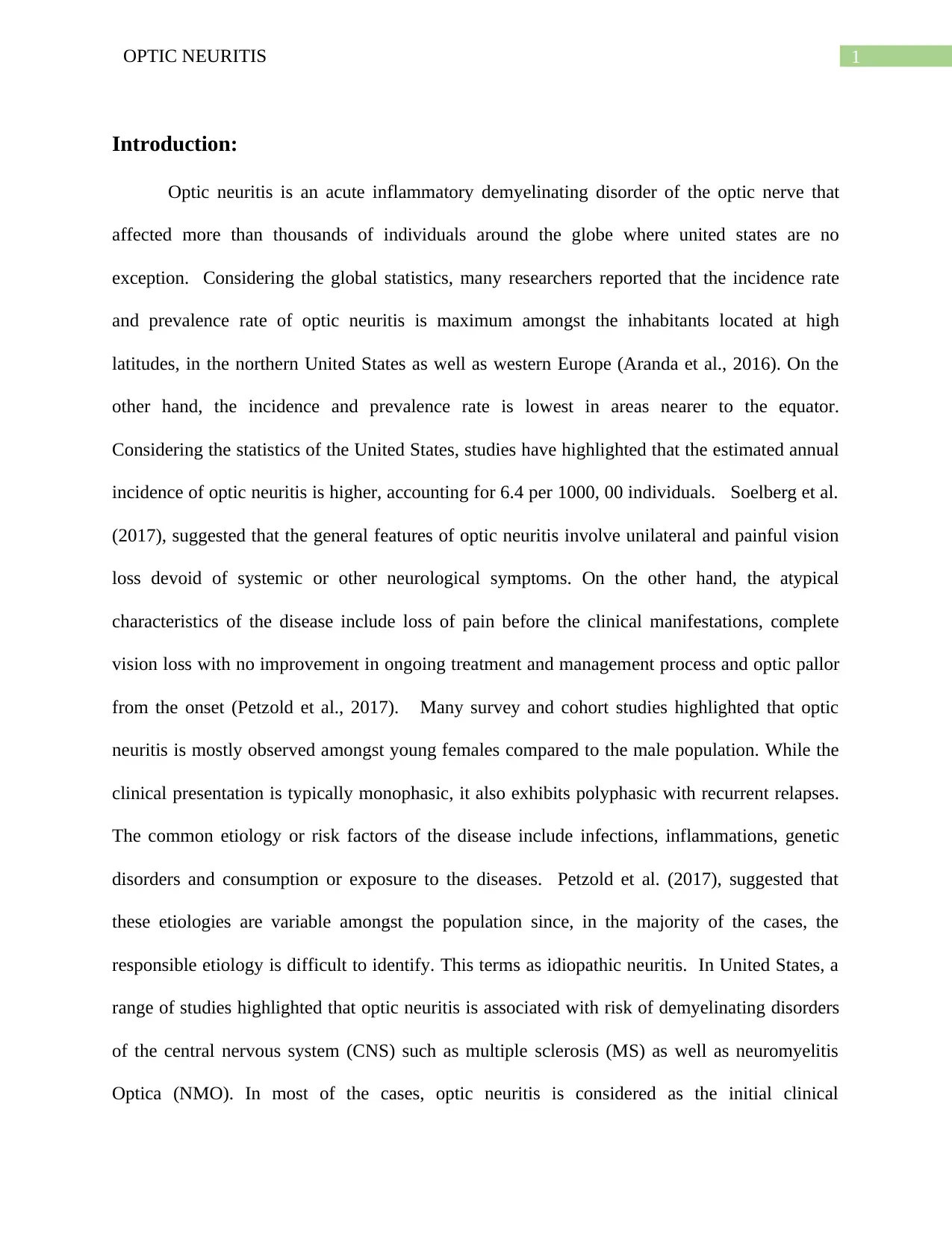
1OPTIC NEURITIS
Introduction:
Optic neuritis is an acute inflammatory demyelinating disorder of the optic nerve that
affected more than thousands of individuals around the globe where united states are no
exception. Considering the global statistics, many researchers reported that the incidence rate
and prevalence rate of optic neuritis is maximum amongst the inhabitants located at high
latitudes, in the northern United States as well as western Europe (Aranda et al., 2016). On the
other hand, the incidence and prevalence rate is lowest in areas nearer to the equator.
Considering the statistics of the United States, studies have highlighted that the estimated annual
incidence of optic neuritis is higher, accounting for 6.4 per 1000, 00 individuals. Soelberg et al.
(2017), suggested that the general features of optic neuritis involve unilateral and painful vision
loss devoid of systemic or other neurological symptoms. On the other hand, the atypical
characteristics of the disease include loss of pain before the clinical manifestations, complete
vision loss with no improvement in ongoing treatment and management process and optic pallor
from the onset (Petzold et al., 2017). Many survey and cohort studies highlighted that optic
neuritis is mostly observed amongst young females compared to the male population. While the
clinical presentation is typically monophasic, it also exhibits polyphasic with recurrent relapses.
The common etiology or risk factors of the disease include infections, inflammations, genetic
disorders and consumption or exposure to the diseases. Petzold et al. (2017), suggested that
these etiologies are variable amongst the population since, in the majority of the cases, the
responsible etiology is difficult to identify. This terms as idiopathic neuritis. In United States, a
range of studies highlighted that optic neuritis is associated with risk of demyelinating disorders
of the central nervous system (CNS) such as multiple sclerosis (MS) as well as neuromyelitis
Optica (NMO). In most of the cases, optic neuritis is considered as the initial clinical
Introduction:
Optic neuritis is an acute inflammatory demyelinating disorder of the optic nerve that
affected more than thousands of individuals around the globe where united states are no
exception. Considering the global statistics, many researchers reported that the incidence rate
and prevalence rate of optic neuritis is maximum amongst the inhabitants located at high
latitudes, in the northern United States as well as western Europe (Aranda et al., 2016). On the
other hand, the incidence and prevalence rate is lowest in areas nearer to the equator.
Considering the statistics of the United States, studies have highlighted that the estimated annual
incidence of optic neuritis is higher, accounting for 6.4 per 1000, 00 individuals. Soelberg et al.
(2017), suggested that the general features of optic neuritis involve unilateral and painful vision
loss devoid of systemic or other neurological symptoms. On the other hand, the atypical
characteristics of the disease include loss of pain before the clinical manifestations, complete
vision loss with no improvement in ongoing treatment and management process and optic pallor
from the onset (Petzold et al., 2017). Many survey and cohort studies highlighted that optic
neuritis is mostly observed amongst young females compared to the male population. While the
clinical presentation is typically monophasic, it also exhibits polyphasic with recurrent relapses.
The common etiology or risk factors of the disease include infections, inflammations, genetic
disorders and consumption or exposure to the diseases. Petzold et al. (2017), suggested that
these etiologies are variable amongst the population since, in the majority of the cases, the
responsible etiology is difficult to identify. This terms as idiopathic neuritis. In United States, a
range of studies highlighted that optic neuritis is associated with risk of demyelinating disorders
of the central nervous system (CNS) such as multiple sclerosis (MS) as well as neuromyelitis
Optica (NMO). In most of the cases, optic neuritis is considered as the initial clinical
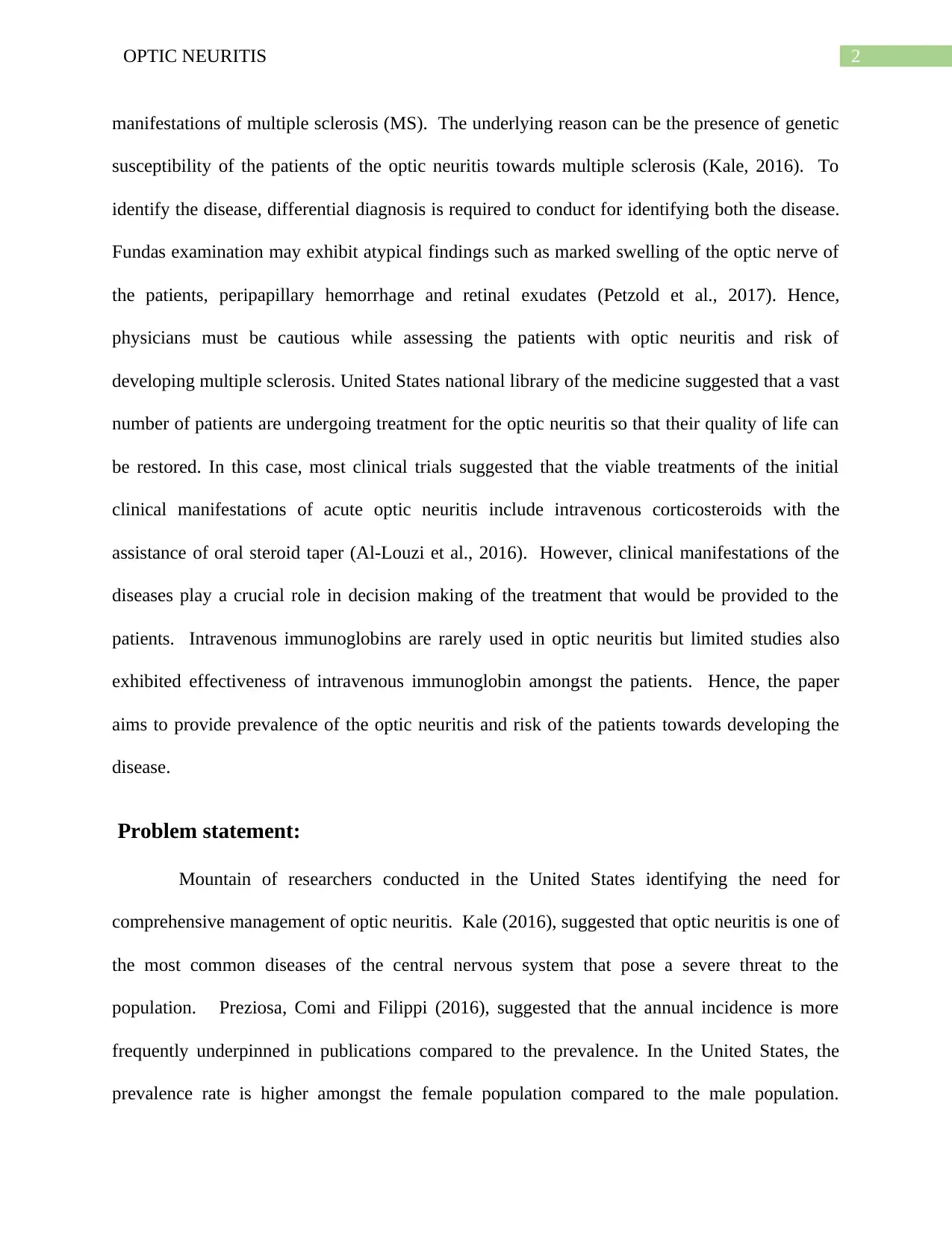
2OPTIC NEURITIS
manifestations of multiple sclerosis (MS). The underlying reason can be the presence of genetic
susceptibility of the patients of the optic neuritis towards multiple sclerosis (Kale, 2016). To
identify the disease, differential diagnosis is required to conduct for identifying both the disease.
Fundas examination may exhibit atypical findings such as marked swelling of the optic nerve of
the patients, peripapillary hemorrhage and retinal exudates (Petzold et al., 2017). Hence,
physicians must be cautious while assessing the patients with optic neuritis and risk of
developing multiple sclerosis. United States national library of the medicine suggested that a vast
number of patients are undergoing treatment for the optic neuritis so that their quality of life can
be restored. In this case, most clinical trials suggested that the viable treatments of the initial
clinical manifestations of acute optic neuritis include intravenous corticosteroids with the
assistance of oral steroid taper (Al-Louzi et al., 2016). However, clinical manifestations of the
diseases play a crucial role in decision making of the treatment that would be provided to the
patients. Intravenous immunoglobins are rarely used in optic neuritis but limited studies also
exhibited effectiveness of intravenous immunoglobin amongst the patients. Hence, the paper
aims to provide prevalence of the optic neuritis and risk of the patients towards developing the
disease.
Problem statement:
Mountain of researchers conducted in the United States identifying the need for
comprehensive management of optic neuritis. Kale (2016), suggested that optic neuritis is one of
the most common diseases of the central nervous system that pose a severe threat to the
population. Preziosa, Comi and Filippi (2016), suggested that the annual incidence is more
frequently underpinned in publications compared to the prevalence. In the United States, the
prevalence rate is higher amongst the female population compared to the male population.
manifestations of multiple sclerosis (MS). The underlying reason can be the presence of genetic
susceptibility of the patients of the optic neuritis towards multiple sclerosis (Kale, 2016). To
identify the disease, differential diagnosis is required to conduct for identifying both the disease.
Fundas examination may exhibit atypical findings such as marked swelling of the optic nerve of
the patients, peripapillary hemorrhage and retinal exudates (Petzold et al., 2017). Hence,
physicians must be cautious while assessing the patients with optic neuritis and risk of
developing multiple sclerosis. United States national library of the medicine suggested that a vast
number of patients are undergoing treatment for the optic neuritis so that their quality of life can
be restored. In this case, most clinical trials suggested that the viable treatments of the initial
clinical manifestations of acute optic neuritis include intravenous corticosteroids with the
assistance of oral steroid taper (Al-Louzi et al., 2016). However, clinical manifestations of the
diseases play a crucial role in decision making of the treatment that would be provided to the
patients. Intravenous immunoglobins are rarely used in optic neuritis but limited studies also
exhibited effectiveness of intravenous immunoglobin amongst the patients. Hence, the paper
aims to provide prevalence of the optic neuritis and risk of the patients towards developing the
disease.
Problem statement:
Mountain of researchers conducted in the United States identifying the need for
comprehensive management of optic neuritis. Kale (2016), suggested that optic neuritis is one of
the most common diseases of the central nervous system that pose a severe threat to the
population. Preziosa, Comi and Filippi (2016), suggested that the annual incidence is more
frequently underpinned in publications compared to the prevalence. In the United States, the
prevalence rate is higher amongst the female population compared to the male population.
⊘ This is a preview!⊘
Do you want full access?
Subscribe today to unlock all pages.

Trusted by 1+ million students worldwide
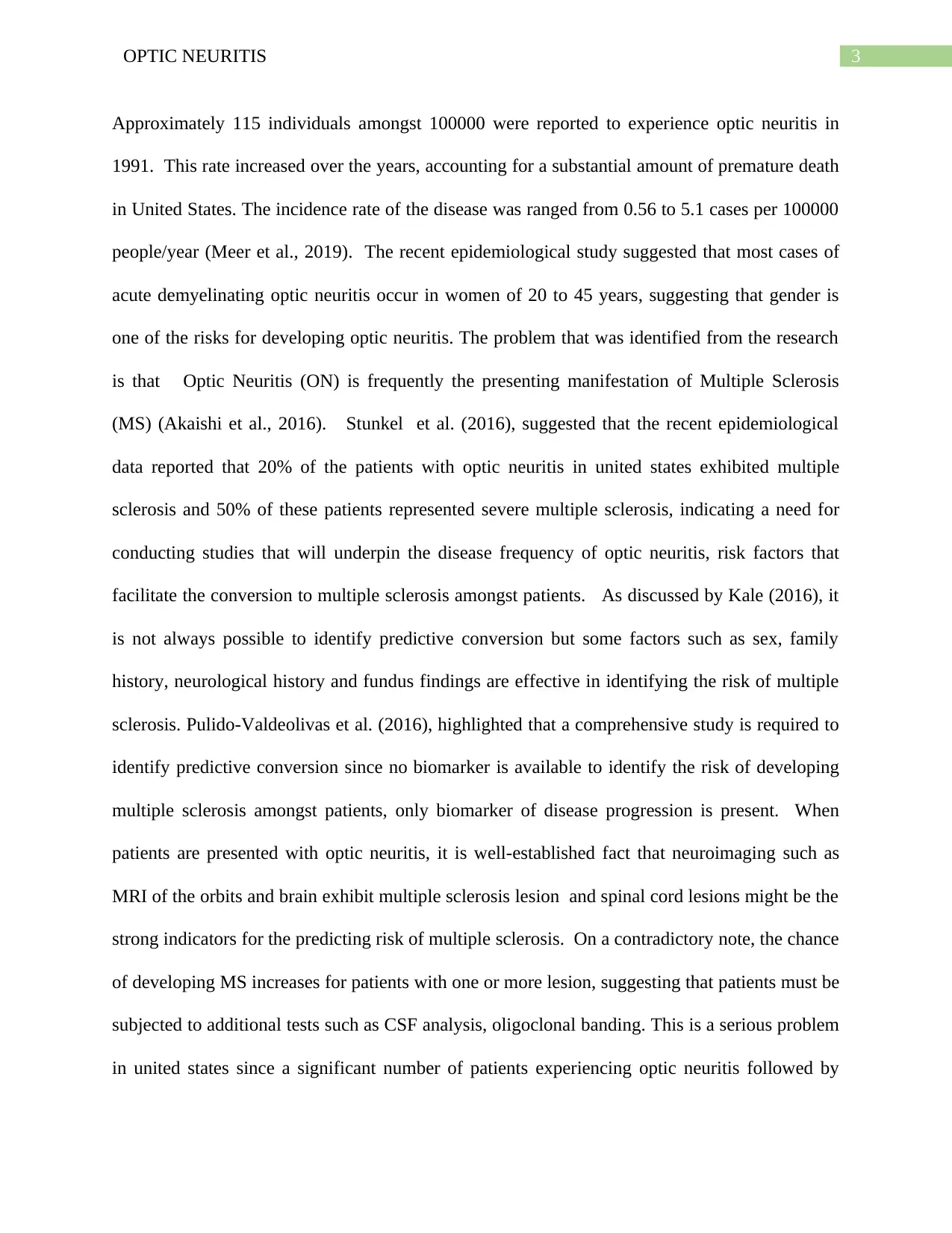
3OPTIC NEURITIS
Approximately 115 individuals amongst 100000 were reported to experience optic neuritis in
1991. This rate increased over the years, accounting for a substantial amount of premature death
in United States. The incidence rate of the disease was ranged from 0.56 to 5.1 cases per 100000
people/year (Meer et al., 2019). The recent epidemiological study suggested that most cases of
acute demyelinating optic neuritis occur in women of 20 to 45 years, suggesting that gender is
one of the risks for developing optic neuritis. The problem that was identified from the research
is that Optic Neuritis (ON) is frequently the presenting manifestation of Multiple Sclerosis
(MS) (Akaishi et al., 2016). Stunkel et al. (2016), suggested that the recent epidemiological
data reported that 20% of the patients with optic neuritis in united states exhibited multiple
sclerosis and 50% of these patients represented severe multiple sclerosis, indicating a need for
conducting studies that will underpin the disease frequency of optic neuritis, risk factors that
facilitate the conversion to multiple sclerosis amongst patients. As discussed by Kale (2016), it
is not always possible to identify predictive conversion but some factors such as sex, family
history, neurological history and fundus findings are effective in identifying the risk of multiple
sclerosis. Pulido-Valdeolivas et al. (2016), highlighted that a comprehensive study is required to
identify predictive conversion since no biomarker is available to identify the risk of developing
multiple sclerosis amongst patients, only biomarker of disease progression is present. When
patients are presented with optic neuritis, it is well-established fact that neuroimaging such as
MRI of the orbits and brain exhibit multiple sclerosis lesion and spinal cord lesions might be the
strong indicators for the predicting risk of multiple sclerosis. On a contradictory note, the chance
of developing MS increases for patients with one or more lesion, suggesting that patients must be
subjected to additional tests such as CSF analysis, oligoclonal banding. This is a serious problem
in united states since a significant number of patients experiencing optic neuritis followed by
Approximately 115 individuals amongst 100000 were reported to experience optic neuritis in
1991. This rate increased over the years, accounting for a substantial amount of premature death
in United States. The incidence rate of the disease was ranged from 0.56 to 5.1 cases per 100000
people/year (Meer et al., 2019). The recent epidemiological study suggested that most cases of
acute demyelinating optic neuritis occur in women of 20 to 45 years, suggesting that gender is
one of the risks for developing optic neuritis. The problem that was identified from the research
is that Optic Neuritis (ON) is frequently the presenting manifestation of Multiple Sclerosis
(MS) (Akaishi et al., 2016). Stunkel et al. (2016), suggested that the recent epidemiological
data reported that 20% of the patients with optic neuritis in united states exhibited multiple
sclerosis and 50% of these patients represented severe multiple sclerosis, indicating a need for
conducting studies that will underpin the disease frequency of optic neuritis, risk factors that
facilitate the conversion to multiple sclerosis amongst patients. As discussed by Kale (2016), it
is not always possible to identify predictive conversion but some factors such as sex, family
history, neurological history and fundus findings are effective in identifying the risk of multiple
sclerosis. Pulido-Valdeolivas et al. (2016), highlighted that a comprehensive study is required to
identify predictive conversion since no biomarker is available to identify the risk of developing
multiple sclerosis amongst patients, only biomarker of disease progression is present. When
patients are presented with optic neuritis, it is well-established fact that neuroimaging such as
MRI of the orbits and brain exhibit multiple sclerosis lesion and spinal cord lesions might be the
strong indicators for the predicting risk of multiple sclerosis. On a contradictory note, the chance
of developing MS increases for patients with one or more lesion, suggesting that patients must be
subjected to additional tests such as CSF analysis, oligoclonal banding. This is a serious problem
in united states since a significant number of patients experiencing optic neuritis followed by
Paraphrase This Document
Need a fresh take? Get an instant paraphrase of this document with our AI Paraphraser
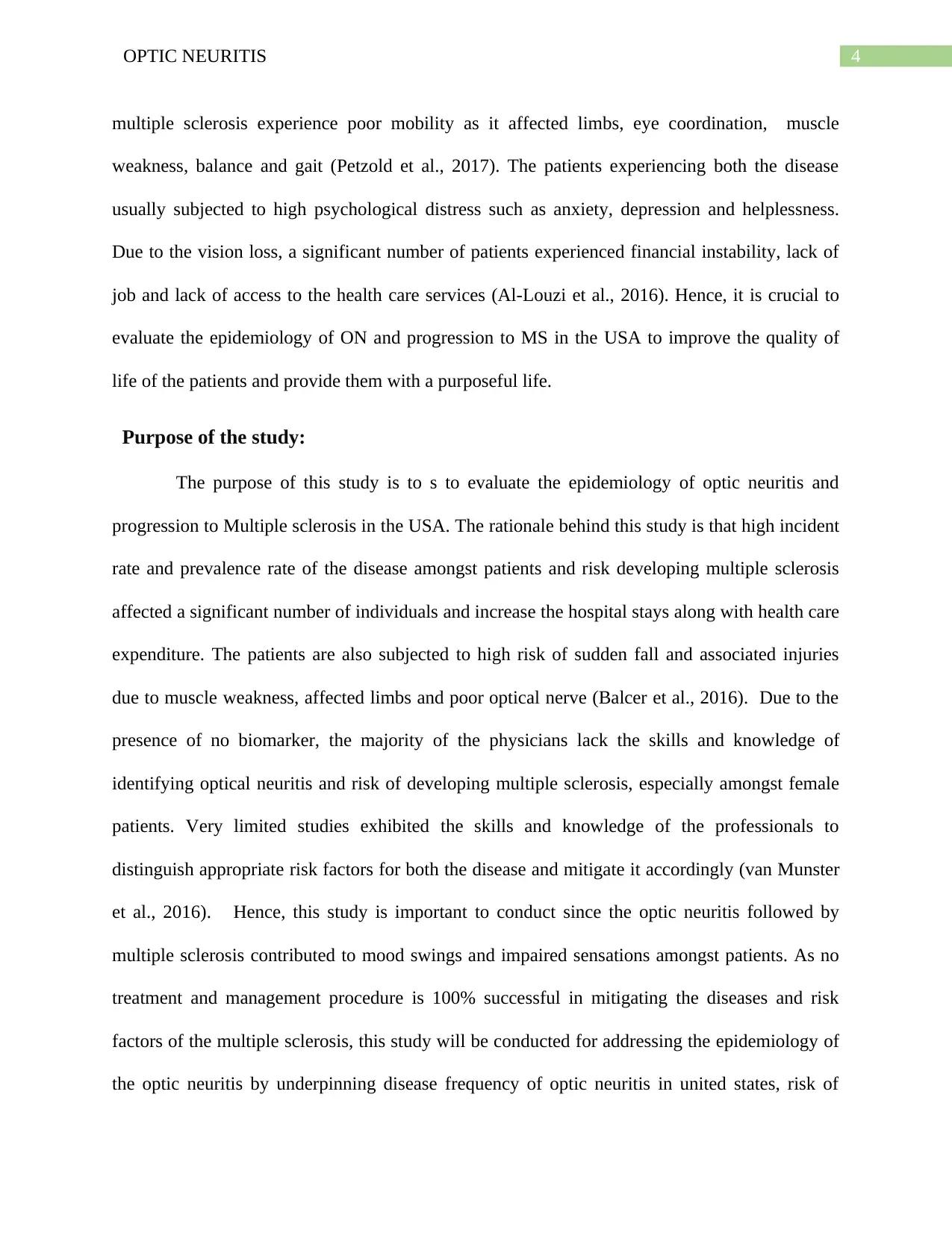
4OPTIC NEURITIS
multiple sclerosis experience poor mobility as it affected limbs, eye coordination, muscle
weakness, balance and gait (Petzold et al., 2017). The patients experiencing both the disease
usually subjected to high psychological distress such as anxiety, depression and helplessness.
Due to the vision loss, a significant number of patients experienced financial instability, lack of
job and lack of access to the health care services (Al-Louzi et al., 2016). Hence, it is crucial to
evaluate the epidemiology of ON and progression to MS in the USA to improve the quality of
life of the patients and provide them with a purposeful life.
Purpose of the study:
The purpose of this study is to s to evaluate the epidemiology of optic neuritis and
progression to Multiple sclerosis in the USA. The rationale behind this study is that high incident
rate and prevalence rate of the disease amongst patients and risk developing multiple sclerosis
affected a significant number of individuals and increase the hospital stays along with health care
expenditure. The patients are also subjected to high risk of sudden fall and associated injuries
due to muscle weakness, affected limbs and poor optical nerve (Balcer et al., 2016). Due to the
presence of no biomarker, the majority of the physicians lack the skills and knowledge of
identifying optical neuritis and risk of developing multiple sclerosis, especially amongst female
patients. Very limited studies exhibited the skills and knowledge of the professionals to
distinguish appropriate risk factors for both the disease and mitigate it accordingly (van Munster
et al., 2016). Hence, this study is important to conduct since the optic neuritis followed by
multiple sclerosis contributed to mood swings and impaired sensations amongst patients. As no
treatment and management procedure is 100% successful in mitigating the diseases and risk
factors of the multiple sclerosis, this study will be conducted for addressing the epidemiology of
the optic neuritis by underpinning disease frequency of optic neuritis in united states, risk of
multiple sclerosis experience poor mobility as it affected limbs, eye coordination, muscle
weakness, balance and gait (Petzold et al., 2017). The patients experiencing both the disease
usually subjected to high psychological distress such as anxiety, depression and helplessness.
Due to the vision loss, a significant number of patients experienced financial instability, lack of
job and lack of access to the health care services (Al-Louzi et al., 2016). Hence, it is crucial to
evaluate the epidemiology of ON and progression to MS in the USA to improve the quality of
life of the patients and provide them with a purposeful life.
Purpose of the study:
The purpose of this study is to s to evaluate the epidemiology of optic neuritis and
progression to Multiple sclerosis in the USA. The rationale behind this study is that high incident
rate and prevalence rate of the disease amongst patients and risk developing multiple sclerosis
affected a significant number of individuals and increase the hospital stays along with health care
expenditure. The patients are also subjected to high risk of sudden fall and associated injuries
due to muscle weakness, affected limbs and poor optical nerve (Balcer et al., 2016). Due to the
presence of no biomarker, the majority of the physicians lack the skills and knowledge of
identifying optical neuritis and risk of developing multiple sclerosis, especially amongst female
patients. Very limited studies exhibited the skills and knowledge of the professionals to
distinguish appropriate risk factors for both the disease and mitigate it accordingly (van Munster
et al., 2016). Hence, this study is important to conduct since the optic neuritis followed by
multiple sclerosis contributed to mood swings and impaired sensations amongst patients. As no
treatment and management procedure is 100% successful in mitigating the diseases and risk
factors of the multiple sclerosis, this study will be conducted for addressing the epidemiology of
the optic neuritis by underpinning disease frequency of optic neuritis in united states, risk of
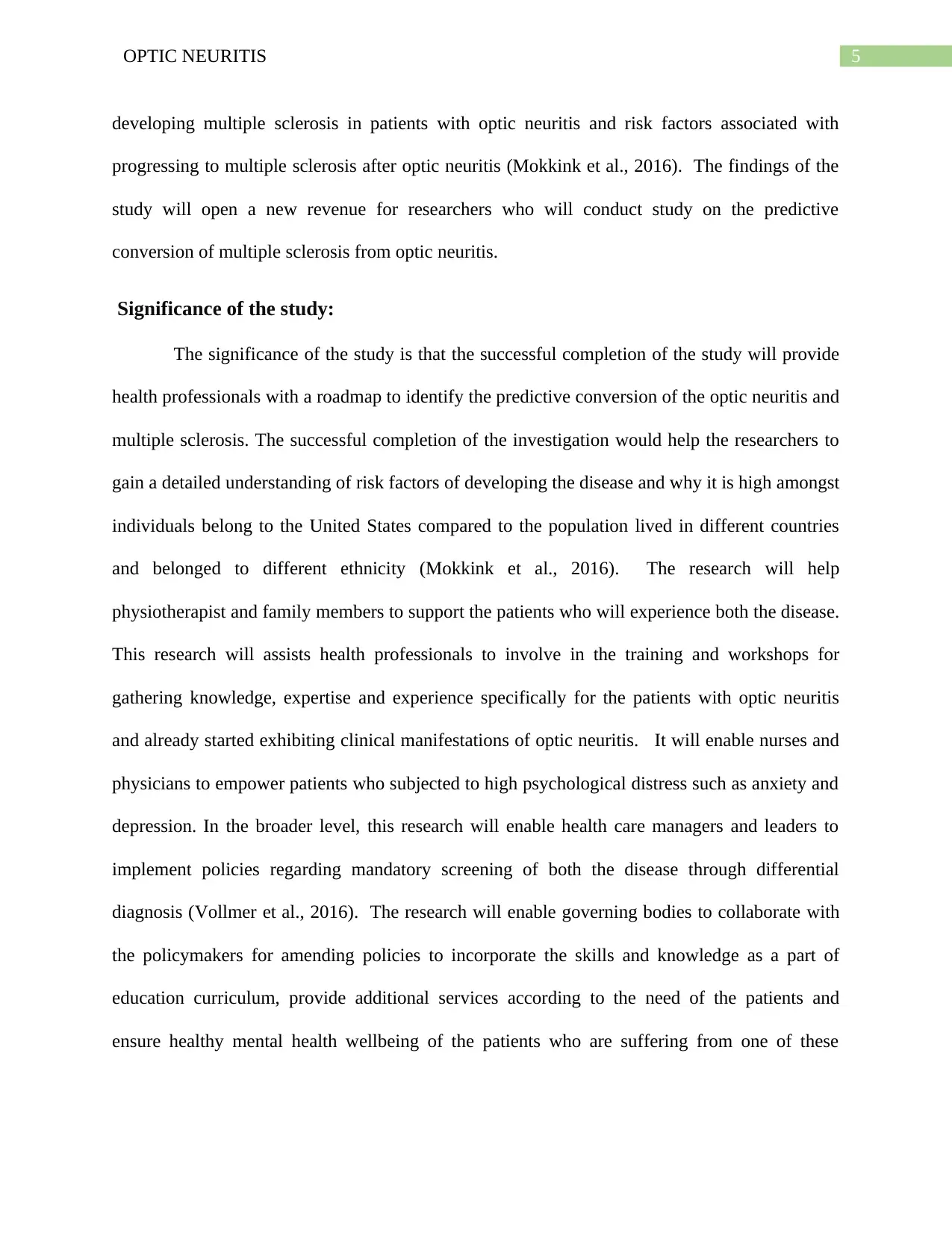
5OPTIC NEURITIS
developing multiple sclerosis in patients with optic neuritis and risk factors associated with
progressing to multiple sclerosis after optic neuritis (Mokkink et al., 2016). The findings of the
study will open a new revenue for researchers who will conduct study on the predictive
conversion of multiple sclerosis from optic neuritis.
Significance of the study:
The significance of the study is that the successful completion of the study will provide
health professionals with a roadmap to identify the predictive conversion of the optic neuritis and
multiple sclerosis. The successful completion of the investigation would help the researchers to
gain a detailed understanding of risk factors of developing the disease and why it is high amongst
individuals belong to the United States compared to the population lived in different countries
and belonged to different ethnicity (Mokkink et al., 2016). The research will help
physiotherapist and family members to support the patients who will experience both the disease.
This research will assists health professionals to involve in the training and workshops for
gathering knowledge, expertise and experience specifically for the patients with optic neuritis
and already started exhibiting clinical manifestations of optic neuritis. It will enable nurses and
physicians to empower patients who subjected to high psychological distress such as anxiety and
depression. In the broader level, this research will enable health care managers and leaders to
implement policies regarding mandatory screening of both the disease through differential
diagnosis (Vollmer et al., 2016). The research will enable governing bodies to collaborate with
the policymakers for amending policies to incorporate the skills and knowledge as a part of
education curriculum, provide additional services according to the need of the patients and
ensure healthy mental health wellbeing of the patients who are suffering from one of these
developing multiple sclerosis in patients with optic neuritis and risk factors associated with
progressing to multiple sclerosis after optic neuritis (Mokkink et al., 2016). The findings of the
study will open a new revenue for researchers who will conduct study on the predictive
conversion of multiple sclerosis from optic neuritis.
Significance of the study:
The significance of the study is that the successful completion of the study will provide
health professionals with a roadmap to identify the predictive conversion of the optic neuritis and
multiple sclerosis. The successful completion of the investigation would help the researchers to
gain a detailed understanding of risk factors of developing the disease and why it is high amongst
individuals belong to the United States compared to the population lived in different countries
and belonged to different ethnicity (Mokkink et al., 2016). The research will help
physiotherapist and family members to support the patients who will experience both the disease.
This research will assists health professionals to involve in the training and workshops for
gathering knowledge, expertise and experience specifically for the patients with optic neuritis
and already started exhibiting clinical manifestations of optic neuritis. It will enable nurses and
physicians to empower patients who subjected to high psychological distress such as anxiety and
depression. In the broader level, this research will enable health care managers and leaders to
implement policies regarding mandatory screening of both the disease through differential
diagnosis (Vollmer et al., 2016). The research will enable governing bodies to collaborate with
the policymakers for amending policies to incorporate the skills and knowledge as a part of
education curriculum, provide additional services according to the need of the patients and
ensure healthy mental health wellbeing of the patients who are suffering from one of these
⊘ This is a preview!⊘
Do you want full access?
Subscribe today to unlock all pages.

Trusted by 1+ million students worldwide

6OPTIC NEURITIS
diseases and are at high risk of developing the second disease. This would assure an
uninterrupted service delivery.
diseases and are at high risk of developing the second disease. This would assure an
uninterrupted service delivery.
Paraphrase This Document
Need a fresh take? Get an instant paraphrase of this document with our AI Paraphraser
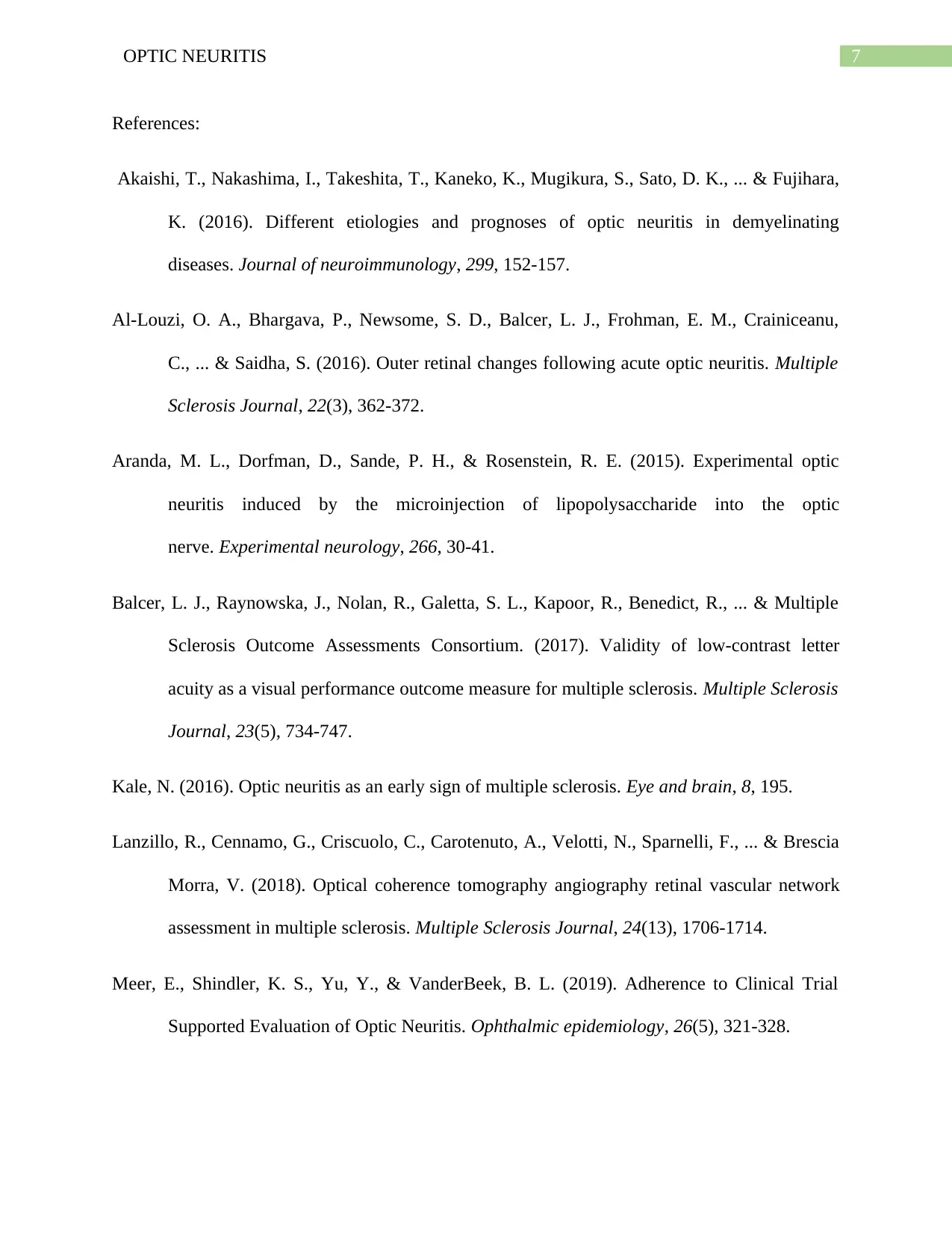
7OPTIC NEURITIS
References:
Akaishi, T., Nakashima, I., Takeshita, T., Kaneko, K., Mugikura, S., Sato, D. K., ... & Fujihara,
K. (2016). Different etiologies and prognoses of optic neuritis in demyelinating
diseases. Journal of neuroimmunology, 299, 152-157.
Al-Louzi, O. A., Bhargava, P., Newsome, S. D., Balcer, L. J., Frohman, E. M., Crainiceanu,
C., ... & Saidha, S. (2016). Outer retinal changes following acute optic neuritis. Multiple
Sclerosis Journal, 22(3), 362-372.
Aranda, M. L., Dorfman, D., Sande, P. H., & Rosenstein, R. E. (2015). Experimental optic
neuritis induced by the microinjection of lipopolysaccharide into the optic
nerve. Experimental neurology, 266, 30-41.
Balcer, L. J., Raynowska, J., Nolan, R., Galetta, S. L., Kapoor, R., Benedict, R., ... & Multiple
Sclerosis Outcome Assessments Consortium. (2017). Validity of low-contrast letter
acuity as a visual performance outcome measure for multiple sclerosis. Multiple Sclerosis
Journal, 23(5), 734-747.
Kale, N. (2016). Optic neuritis as an early sign of multiple sclerosis. Eye and brain, 8, 195.
Lanzillo, R., Cennamo, G., Criscuolo, C., Carotenuto, A., Velotti, N., Sparnelli, F., ... & Brescia
Morra, V. (2018). Optical coherence tomography angiography retinal vascular network
assessment in multiple sclerosis. Multiple Sclerosis Journal, 24(13), 1706-1714.
Meer, E., Shindler, K. S., Yu, Y., & VanderBeek, B. L. (2019). Adherence to Clinical Trial
Supported Evaluation of Optic Neuritis. Ophthalmic epidemiology, 26(5), 321-328.
References:
Akaishi, T., Nakashima, I., Takeshita, T., Kaneko, K., Mugikura, S., Sato, D. K., ... & Fujihara,
K. (2016). Different etiologies and prognoses of optic neuritis in demyelinating
diseases. Journal of neuroimmunology, 299, 152-157.
Al-Louzi, O. A., Bhargava, P., Newsome, S. D., Balcer, L. J., Frohman, E. M., Crainiceanu,
C., ... & Saidha, S. (2016). Outer retinal changes following acute optic neuritis. Multiple
Sclerosis Journal, 22(3), 362-372.
Aranda, M. L., Dorfman, D., Sande, P. H., & Rosenstein, R. E. (2015). Experimental optic
neuritis induced by the microinjection of lipopolysaccharide into the optic
nerve. Experimental neurology, 266, 30-41.
Balcer, L. J., Raynowska, J., Nolan, R., Galetta, S. L., Kapoor, R., Benedict, R., ... & Multiple
Sclerosis Outcome Assessments Consortium. (2017). Validity of low-contrast letter
acuity as a visual performance outcome measure for multiple sclerosis. Multiple Sclerosis
Journal, 23(5), 734-747.
Kale, N. (2016). Optic neuritis as an early sign of multiple sclerosis. Eye and brain, 8, 195.
Lanzillo, R., Cennamo, G., Criscuolo, C., Carotenuto, A., Velotti, N., Sparnelli, F., ... & Brescia
Morra, V. (2018). Optical coherence tomography angiography retinal vascular network
assessment in multiple sclerosis. Multiple Sclerosis Journal, 24(13), 1706-1714.
Meer, E., Shindler, K. S., Yu, Y., & VanderBeek, B. L. (2019). Adherence to Clinical Trial
Supported Evaluation of Optic Neuritis. Ophthalmic epidemiology, 26(5), 321-328.
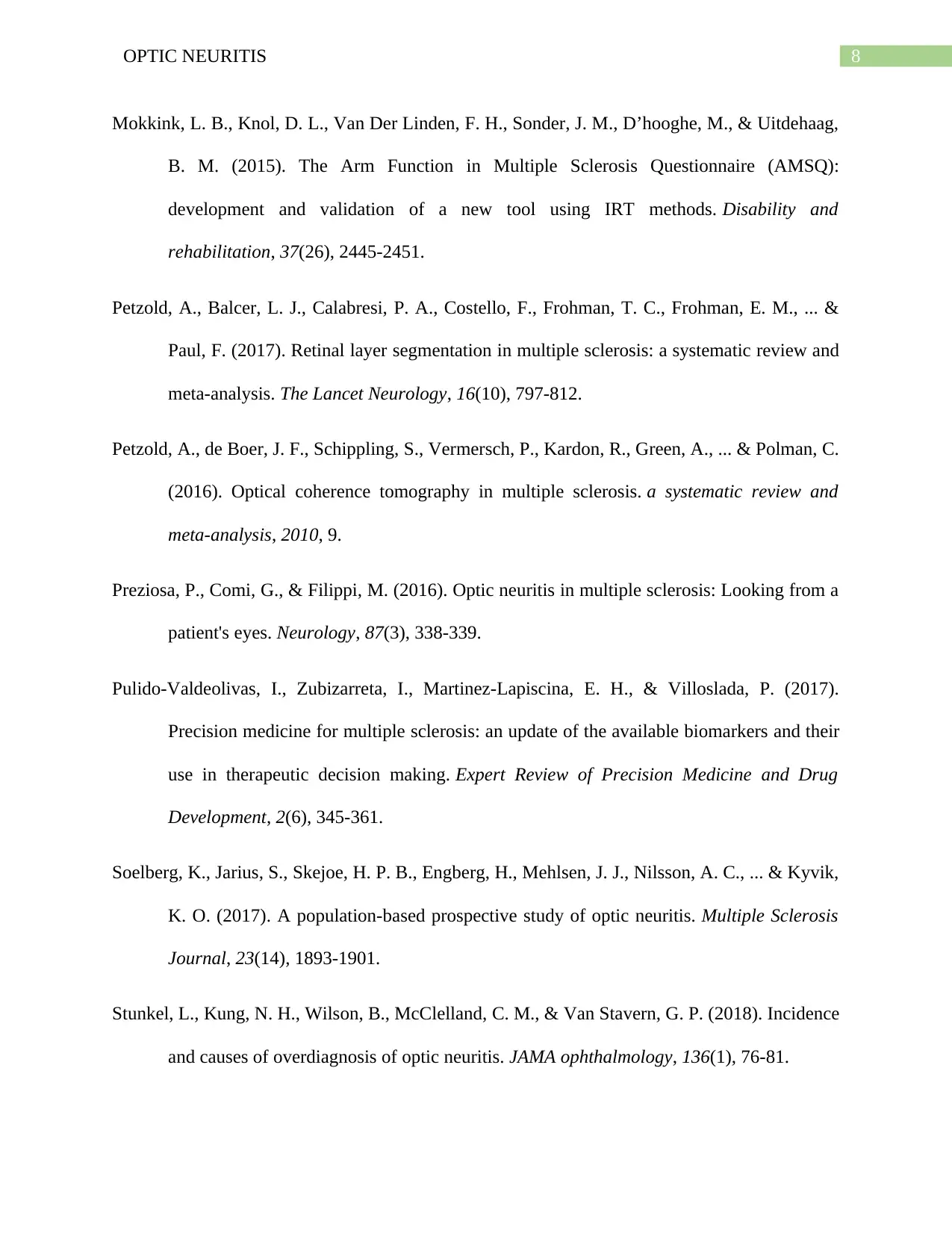
8OPTIC NEURITIS
Mokkink, L. B., Knol, D. L., Van Der Linden, F. H., Sonder, J. M., D’hooghe, M., & Uitdehaag,
B. M. (2015). The Arm Function in Multiple Sclerosis Questionnaire (AMSQ):
development and validation of a new tool using IRT methods. Disability and
rehabilitation, 37(26), 2445-2451.
Petzold, A., Balcer, L. J., Calabresi, P. A., Costello, F., Frohman, T. C., Frohman, E. M., ... &
Paul, F. (2017). Retinal layer segmentation in multiple sclerosis: a systematic review and
meta-analysis. The Lancet Neurology, 16(10), 797-812.
Petzold, A., de Boer, J. F., Schippling, S., Vermersch, P., Kardon, R., Green, A., ... & Polman, C.
(2016). Optical coherence tomography in multiple sclerosis. a systematic review and
meta-analysis, 2010, 9.
Preziosa, P., Comi, G., & Filippi, M. (2016). Optic neuritis in multiple sclerosis: Looking from a
patient's eyes. Neurology, 87(3), 338-339.
Pulido-Valdeolivas, I., Zubizarreta, I., Martinez-Lapiscina, E. H., & Villoslada, P. (2017).
Precision medicine for multiple sclerosis: an update of the available biomarkers and their
use in therapeutic decision making. Expert Review of Precision Medicine and Drug
Development, 2(6), 345-361.
Soelberg, K., Jarius, S., Skejoe, H. P. B., Engberg, H., Mehlsen, J. J., Nilsson, A. C., ... & Kyvik,
K. O. (2017). A population-based prospective study of optic neuritis. Multiple Sclerosis
Journal, 23(14), 1893-1901.
Stunkel, L., Kung, N. H., Wilson, B., McClelland, C. M., & Van Stavern, G. P. (2018). Incidence
and causes of overdiagnosis of optic neuritis. JAMA ophthalmology, 136(1), 76-81.
Mokkink, L. B., Knol, D. L., Van Der Linden, F. H., Sonder, J. M., D’hooghe, M., & Uitdehaag,
B. M. (2015). The Arm Function in Multiple Sclerosis Questionnaire (AMSQ):
development and validation of a new tool using IRT methods. Disability and
rehabilitation, 37(26), 2445-2451.
Petzold, A., Balcer, L. J., Calabresi, P. A., Costello, F., Frohman, T. C., Frohman, E. M., ... &
Paul, F. (2017). Retinal layer segmentation in multiple sclerosis: a systematic review and
meta-analysis. The Lancet Neurology, 16(10), 797-812.
Petzold, A., de Boer, J. F., Schippling, S., Vermersch, P., Kardon, R., Green, A., ... & Polman, C.
(2016). Optical coherence tomography in multiple sclerosis. a systematic review and
meta-analysis, 2010, 9.
Preziosa, P., Comi, G., & Filippi, M. (2016). Optic neuritis in multiple sclerosis: Looking from a
patient's eyes. Neurology, 87(3), 338-339.
Pulido-Valdeolivas, I., Zubizarreta, I., Martinez-Lapiscina, E. H., & Villoslada, P. (2017).
Precision medicine for multiple sclerosis: an update of the available biomarkers and their
use in therapeutic decision making. Expert Review of Precision Medicine and Drug
Development, 2(6), 345-361.
Soelberg, K., Jarius, S., Skejoe, H. P. B., Engberg, H., Mehlsen, J. J., Nilsson, A. C., ... & Kyvik,
K. O. (2017). A population-based prospective study of optic neuritis. Multiple Sclerosis
Journal, 23(14), 1893-1901.
Stunkel, L., Kung, N. H., Wilson, B., McClelland, C. M., & Van Stavern, G. P. (2018). Incidence
and causes of overdiagnosis of optic neuritis. JAMA ophthalmology, 136(1), 76-81.
⊘ This is a preview!⊘
Do you want full access?
Subscribe today to unlock all pages.

Trusted by 1+ million students worldwide
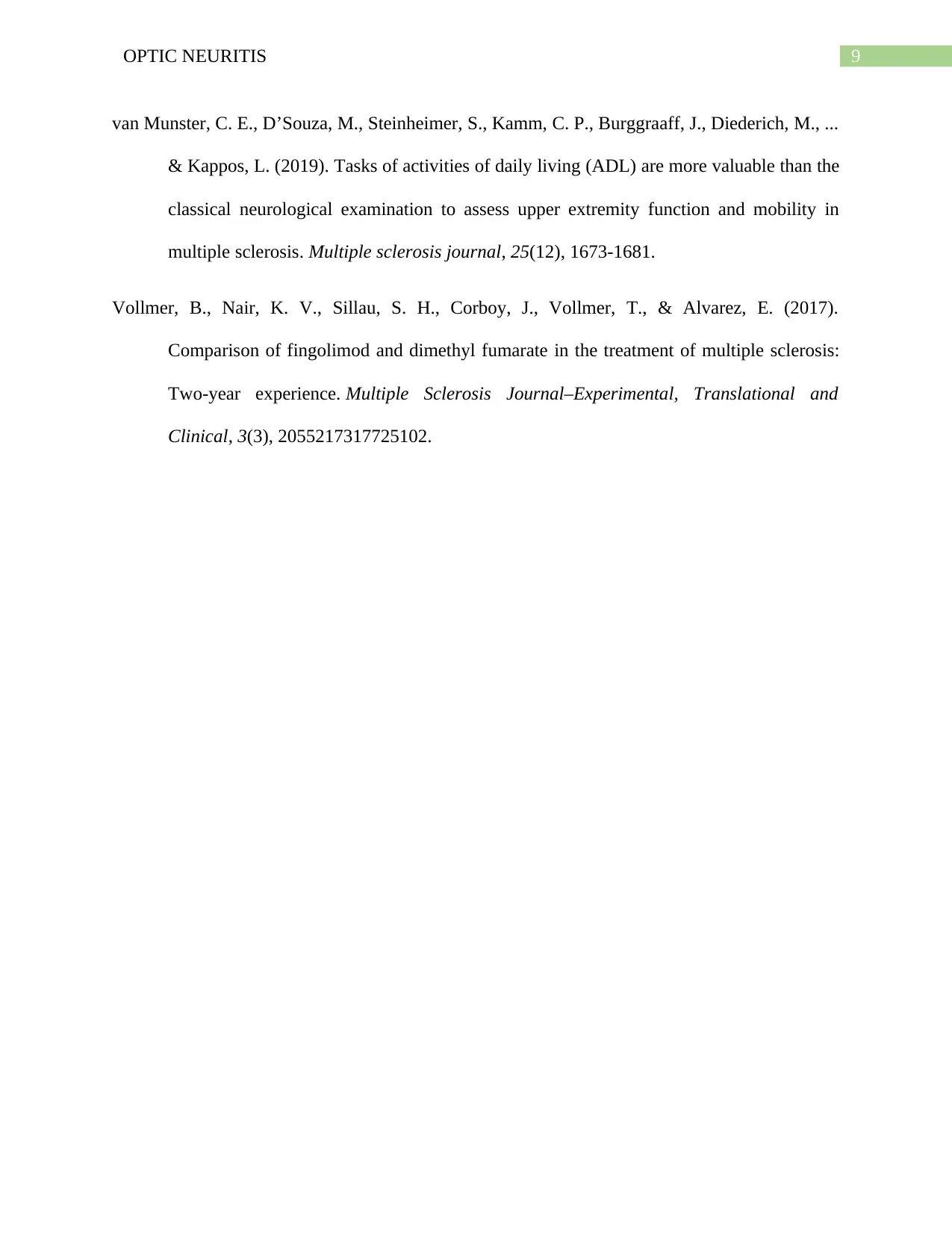
9OPTIC NEURITIS
van Munster, C. E., D’Souza, M., Steinheimer, S., Kamm, C. P., Burggraaff, J., Diederich, M., ...
& Kappos, L. (2019). Tasks of activities of daily living (ADL) are more valuable than the
classical neurological examination to assess upper extremity function and mobility in
multiple sclerosis. Multiple sclerosis journal, 25(12), 1673-1681.
Vollmer, B., Nair, K. V., Sillau, S. H., Corboy, J., Vollmer, T., & Alvarez, E. (2017).
Comparison of fingolimod and dimethyl fumarate in the treatment of multiple sclerosis:
Two-year experience. Multiple Sclerosis Journal–Experimental, Translational and
Clinical, 3(3), 2055217317725102.
van Munster, C. E., D’Souza, M., Steinheimer, S., Kamm, C. P., Burggraaff, J., Diederich, M., ...
& Kappos, L. (2019). Tasks of activities of daily living (ADL) are more valuable than the
classical neurological examination to assess upper extremity function and mobility in
multiple sclerosis. Multiple sclerosis journal, 25(12), 1673-1681.
Vollmer, B., Nair, K. V., Sillau, S. H., Corboy, J., Vollmer, T., & Alvarez, E. (2017).
Comparison of fingolimod and dimethyl fumarate in the treatment of multiple sclerosis:
Two-year experience. Multiple Sclerosis Journal–Experimental, Translational and
Clinical, 3(3), 2055217317725102.
1 out of 10
Related Documents
Your All-in-One AI-Powered Toolkit for Academic Success.
+13062052269
info@desklib.com
Available 24*7 on WhatsApp / Email
![[object Object]](/_next/static/media/star-bottom.7253800d.svg)
Unlock your academic potential
Copyright © 2020–2025 A2Z Services. All Rights Reserved. Developed and managed by ZUCOL.





